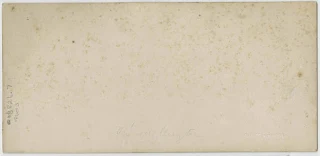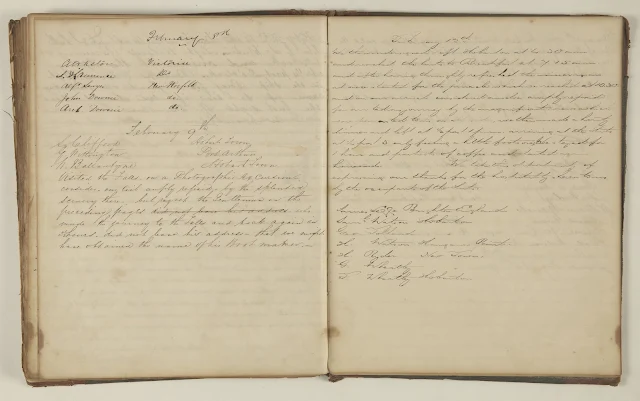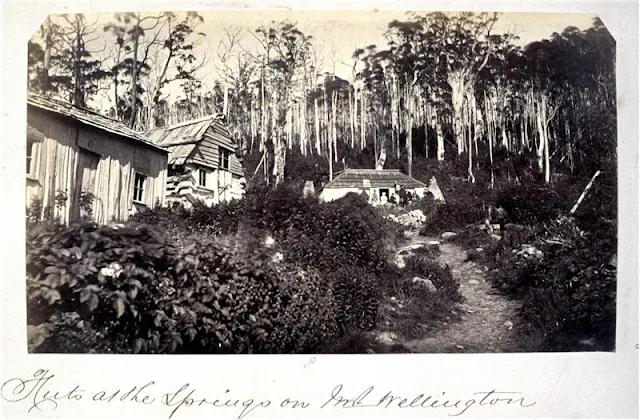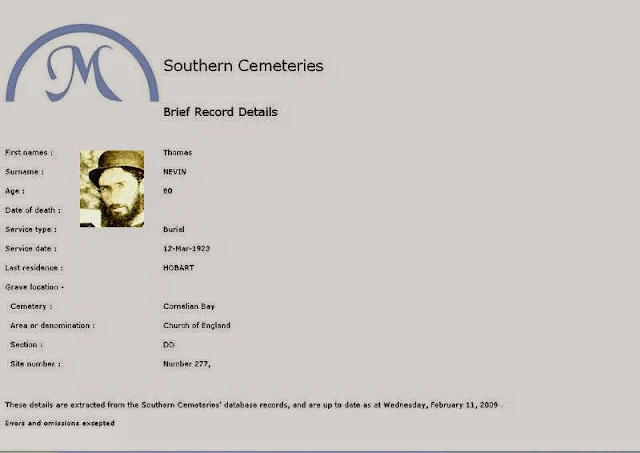THE PEDDER COLLECTION (TMAG) Stereographs by Thomas J. Nevin
NEVIN FAMILY at Kangaroo Valley (Lenah Valley, Tas)
Lady Franklin Museum stereograph (TMAG)
This fine stereograph by Thomas J. Nevin which is held at the Tasmanian Museum and Art Gallery was noted verso by someone in pencil as "best picture". It may have been chosen by Dan Sprod for publication in 1977 (see book below), or it may have been used as early as 1949 by the Tasmanian Amateur Cine Society when they produced a silent 16mm film of the re-opening ceremony of Lady Franklin Museum. A black and white single image printed from this stereograph appears third in the opening sequence of stills (see video below).

Group on the steps of Lady Franklin's Museum, Ancanthe, Kangaroo Valley, Hobart.
Stereograph by Thomas J. Nevin ca. 1868
TMAG Ref: Q1994.56.34

Verso: Group on the steps of the Lady Franklin Museum, Ancanthe, Kangaroo Valley, Hobart.
Stereograph by Thomas J. Nevin ca. 1868
TMAG Ref: Q1994.56.34
No longer available online, this stereograph was catalogued online at the Tasmanian Museum and Art Gallery in 2006 with the following details:
TMAG Catalogue (text database):
Ref: Q1994.56.34
ITEM NAME: Photograph:
MEDIUM: sepia salt paper stereoscope,
MAKER: T Nevin [Artist];
TITLE: 'Lady Franklin's Museum, Kangaroo Valley'
DATE: 1870c
DESCRIPTION : Group of people at Lady Franklin's Museum, Kangaroo Valley
INSCRIPTIONS & MARKS: On back in pencil: Mrs A Pedder / and in different hand Lady Franklin's Museum/ KangarooValley and in different hand again best picture.
This fine stereograph by Thomas J. Nevin which is held at the Tasmanian Museum and Art Gallery was noted verso by someone in pencil as "best picture". It may have been chosen by Dan Sprod for publication in 1977 (see book below), or it may have been used as early as 1949 by the Tasmanian Amateur Cine Society when they produced a silent 16mm film of the re-opening ceremony of Lady Franklin Museum. A black and white single image printed from this stereograph appears third in the opening sequence of stills (see video below).

Group on the steps of Lady Franklin's Museum, Ancanthe, Kangaroo Valley, Hobart.
Stereograph by Thomas J. Nevin ca. 1868
TMAG Ref: Q1994.56.34

Verso: Group on the steps of the Lady Franklin Museum, Ancanthe, Kangaroo Valley, Hobart.
Stereograph by Thomas J. Nevin ca. 1868
TMAG Ref: Q1994.56.34
No longer available online, this stereograph was catalogued online at the Tasmanian Museum and Art Gallery in 2006 with the following details:
TMAG Catalogue (text database):
Ref: Q1994.56.34
ITEM NAME: Photograph:
MEDIUM: sepia salt paper stereoscope,
MAKER: T Nevin [Artist];
TITLE: 'Lady Franklin's Museum, Kangaroo Valley'
DATE: 1870c
DESCRIPTION : Group of people at Lady Franklin's Museum, Kangaroo Valley
INSCRIPTIONS & MARKS: On back in pencil: Mrs A Pedder / and in different hand Lady Franklin's Museum/ KangarooValley and in different hand again best picture.
Royal Society of Tasmania print (UTas)
This print from Thomas Nevin's stereograph of a group at the Lady Franklin Museum, Kangaroo Valley, Tasmania, is held in the Royal Society's Special Collections, University of Tasmania library. Frederick Stops, a colleague of Nevin's at the Municipal Police Office who was the right-hand man to the Attorney-General the Hon. W. G. Giblin, may have acquired it along with another landscape by Nevin - Melville St. Under Snow(1868) - prints of which subsequently surfaced in the TMAG Collections as well in the Royal Society collections at the University of Tasmania. Frederick Stop's son, W. J. T. Stops, was Vice-chancellor of the university at the time of his father's death in 1926.
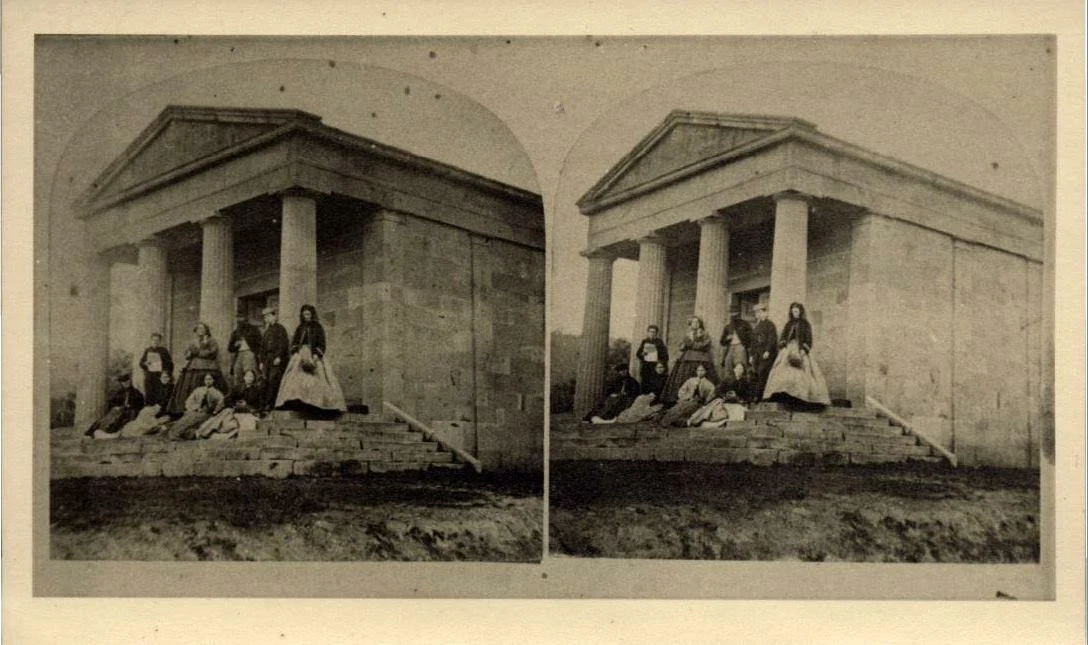
Group at the Lady Franklin Museum Kangaroo Valley (Tas)
Stereograph c.a. 1871 by Thomas J. Nevin
Royal Society ePrints University of Tasmania No. 18-9
This print from Thomas Nevin's stereograph of a group at the Lady Franklin Museum, Kangaroo Valley, Tasmania, is held in the Royal Society's Special Collections, University of Tasmania library. Frederick Stops, a colleague of Nevin's at the Municipal Police Office who was the right-hand man to the Attorney-General the Hon. W. G. Giblin, may have acquired it along with another landscape by Nevin - Melville St. Under Snow(1868) - prints of which subsequently surfaced in the TMAG Collections as well in the Royal Society collections at the University of Tasmania. Frederick Stop's son, W. J. T. Stops, was Vice-chancellor of the university at the time of his father's death in 1926.

Group at the Lady Franklin Museum Kangaroo Valley (Tas)
Stereograph c.a. 1871 by Thomas J. Nevin
Royal Society ePrints University of Tasmania No. 18-9
Tasmanian Amateur Cine Society 1949
Watch the women in their period costumes battle the wind!
Source: YouTube Link: https://youtu.be/qD_m4aU1sJA
Dan Sprod's compilation 1977

This black and white image was poorly reproduced from the original stereograph by Thomas Nevin for inclusion in the 1977 compilation of old photographs published with the title Victorian and Edwardian Hobart from old photographs by Dan Sprod. No index was included in the final book, nor were attributions by name to Thomas Nevin for several of his photographs including this reproduction from Nevin's stereograph of the group at the Lady Franklin Museum. The date given by Sprod is a little too early. It was taken by Nevin ca. 1867-8 in a series of stereographs he produced for visitors to Kangaroo Valley (now Lenah Valley) which included a group at Sir John Franklin's tree.
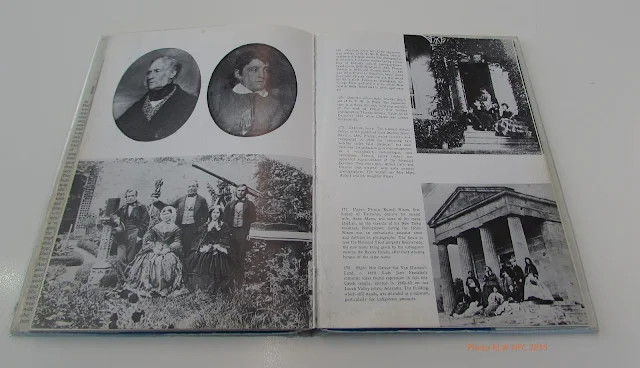
Photo copyright © KLW NFC 2015
CAPTION:
172. Right. Not Greece but Van Diemen's Land, ca. 1860. Lady Jane Franklin's romantic ideas found expression in this tiny Greek temple, erected in 1842-43 on her Lenah Valley estate, Ancanthe, The building, which still stands, was intended as a museum, particularly for indigenous products.

Photo copyright © KLW NFC 2015
Victorian and Edwardian Hobart from old photographs / [compiled by] Dan Sprod.
Publisher: St. Ives, N.S.W. : John Ferguson, 1977.
Description: 1 vol.
ISBN: 0909134065 :
Notes: Hobart. Social life, 1850-1910. Illustrations (ANB/PRECIS SIN 0152382)
Subjects: Hobart (Tas.)--History--Pictorial works.
Hobart (Tas.)--Social life and customs--Pictorial works.
Other Authors: Sprod, Dan, 1924-, comp.
Bib ID: 2222496

The bridge in the foreground crosses the New Town rivulet. The Lady Franklin Museum sits below the site where John Nevin snr built his cottage (now demolished), next to the house (pictured) above on the rise at 270A Lenah Valley Rd. Photos copyright © KLW NFC Imprint 2012 ARR.
Watch the women in their period costumes battle the wind!
Source: YouTube Link: https://youtu.be/qD_m4aU1sJA
Tasmanian Archives: The Tasmanian Amateur Cine Society Presents Re-opening ceremony of Lady Franklin Museum ; shows Sir Hugh and Lady Binney, Stephen Hickman, Robert and Gertrude Cosgrove; guests dressed in period costume. See Mercury 14 Nov 1949, p1 and p4. (black and white, silent) - 16mm B&W 24 fps 100 ft - 4m 14s - Reference: NS6350/1/22

This black and white image was poorly reproduced from the original stereograph by Thomas Nevin for inclusion in the 1977 compilation of old photographs published with the title Victorian and Edwardian Hobart from old photographs by Dan Sprod. No index was included in the final book, nor were attributions by name to Thomas Nevin for several of his photographs including this reproduction from Nevin's stereograph of the group at the Lady Franklin Museum. The date given by Sprod is a little too early. It was taken by Nevin ca. 1867-8 in a series of stereographs he produced for visitors to Kangaroo Valley (now Lenah Valley) which included a group at Sir John Franklin's tree.

Photo copyright © KLW NFC 2015
CAPTION:
172. Right. Not Greece but Van Diemen's Land, ca. 1860. Lady Jane Franklin's romantic ideas found expression in this tiny Greek temple, erected in 1842-43 on her Lenah Valley estate, Ancanthe, The building, which still stands, was intended as a museum, particularly for indigenous products.

Photo copyright © KLW NFC 2015
Victorian and Edwardian Hobart from old photographs / [compiled by] Dan Sprod.
Publisher: St. Ives, N.S.W. : John Ferguson, 1977.
Description: 1 vol.
ISBN: 0909134065 :
Notes: Hobart. Social life, 1850-1910. Illustrations (ANB/PRECIS SIN 0152382)
Subjects: Hobart (Tas.)--History--Pictorial works.
Hobart (Tas.)--Social life and customs--Pictorial works.
Other Authors: Sprod, Dan, 1924-, comp.
Bib ID: 2222496
The bridge in the foreground crosses the New Town rivulet. The Lady Franklin Museum sits below the site where John Nevin snr built his cottage (now demolished), next to the house (pictured) above on the rise at 270A Lenah Valley Rd. Photos copyright © KLW NFC Imprint 2012 ARR.
Thomas Nevin at Kangaroo Valley
From a grant of 2560 acres five miles north of Hobart to George Hull in 1824, Jane Franklin, wife of lieutenant-governor Sir John Franklin purchased 400 acres (162 ha) in the Kangaroo Valley area near New Town from Hull's estate in 1839 which she named Ancanthe and where she built her museum, hoping to house the colony's natural specimens and a library. Thomas Nevin's father John Nevin snr, built his cottage in 1854 on the one acre within the boundaries of Lady Franklin's estate which was managed in trust to the Wesleyan Church after Lady Franklin's departure in 1843. The photograph Thomas J. Nevin took of the house his father built was exhibited at the Wellington Exhibition in 1868 to complement his father's poem titled "My Cottage in the Wilderness" published the same year. John Nevin snr remained there until his death in 1887.
THE LADY FRANKLIN MUSEUM IN 1871

From Walch's Tasmanian Guide 1871 © KLW NFC Imprint 2012
At Kangaroo Valley, Thomas Nevin photographed day-trippers to the Lady Franklin Museum, school buildings, school children and their teachers, farmers and their fields, ferns with and without snow, rushing water and glistening rocks while developing skills in commercial outdoor stereography from at least 1864.Still a bachelor until 1871, he periodically resided with his parents and two surviving siblings at the house his father John Nevin snr had built on land above the Lady Franklin Museum in the early 1850s. The Museum sat adjacent to the Wesleyan Chapel where John Nevin snr and his daughter Mary Ann Nevin taught school. Although Thomas Nevin had acquired the lease and stock-in-trade of a fully functioning commercial studio in the business district of Hobart Town by 1867 from friend and colleague Alfred Bock, he maintained a separate small commercial studio in New Town close to Ancanthe until the birth of his last child in 1888.

Lenah Valley (1973).Ref: 5172-18.
Southern Met maps
AUTAS001139610562-5172-18
Archives Office Tasmania
John Nevin built his "cottage" in 1854 on land in trust to the Wesleyan Church above the Lady Franklin Museum. The house, since demolished, was located inside the boundaries visible in this Southern Met map of 1973. The land was sold by the Hobart City Council on it acquisition from the Church Trustees (those originally designated by Lady Jane Franklin) in the 1920s.
From a grant of 2560 acres five miles north of Hobart to George Hull in 1824, Jane Franklin, wife of lieutenant-governor Sir John Franklin purchased 400 acres (162 ha) in the Kangaroo Valley area near New Town from Hull's estate in 1839 which she named Ancanthe and where she built her museum, hoping to house the colony's natural specimens and a library. Thomas Nevin's father John Nevin snr, built his cottage in 1854 on the one acre within the boundaries of Lady Franklin's estate which was managed in trust to the Wesleyan Church after Lady Franklin's departure in 1843. The photograph Thomas J. Nevin took of the house his father built was exhibited at the Wellington Exhibition in 1868 to complement his father's poem titled "My Cottage in the Wilderness" published the same year. John Nevin snr remained there until his death in 1887.
THE LADY FRANKLIN MUSEUM IN 1871
From Walch's Tasmanian Guide 1871 © KLW NFC Imprint 2012
At Kangaroo Valley, Thomas Nevin photographed day-trippers to the Lady Franklin Museum, school buildings, school children and their teachers, farmers and their fields, ferns with and without snow, rushing water and glistening rocks while developing skills in commercial outdoor stereography from at least 1864.Still a bachelor until 1871, he periodically resided with his parents and two surviving siblings at the house his father John Nevin snr had built on land above the Lady Franklin Museum in the early 1850s. The Museum sat adjacent to the Wesleyan Chapel where John Nevin snr and his daughter Mary Ann Nevin taught school. Although Thomas Nevin had acquired the lease and stock-in-trade of a fully functioning commercial studio in the business district of Hobart Town by 1867 from friend and colleague Alfred Bock, he maintained a separate small commercial studio in New Town close to Ancanthe until the birth of his last child in 1888.

Lenah Valley (1973).Ref: 5172-18.
Southern Met maps
AUTAS001139610562-5172-18
Archives Office Tasmania
John Nevin built his "cottage" in 1854 on land in trust to the Wesleyan Church above the Lady Franklin Museum. The house, since demolished, was located inside the boundaries visible in this Southern Met map of 1973. The land was sold by the Hobart City Council on it acquisition from the Church Trustees (those originally designated by Lady Jane Franklin) in the 1920s.
The Pedder Collection (TMAG)
Lawyers, barristers, magistrates, politicians, police superintendents, detectives, their families and their prisoners were photographed by Thomas J. Nevin from the late 1860s to the 1880s. The Pedder family of magistrates and police officers, the family of solicitor John Woodcock Graves the younger, the McVilly family of teachers and police officers, and the family of Attorney-General the Hon. W. R. Giblin, all made use of Thomas J. Nevin's commission with the colonial government's Lands and Survey Department, the Municipal Police Office and Mayor's Court, and the Hobart City Corporation to provide them with stereographic views and carte-de-visite portraits. The stereograph by Thomas J. Nevin ca. 1868-1870 of the Lady Franklin Museum, Kangaroo Valley bearing the inscription "A. Pedder" on verso, is one of least four held in the Tasmanian Museum and Art Gallery collections. Solicitor Alfred Pedder (1881-1977) may have kept these stereographs by Thomas Nevin from the estate of his father, Police Superintendent Frederick Pedder (1841-1923) who was also a colleague of Nevin's at the Municipal Police Office, Hobart. Alfred Pedder's daughter Sylvia in turn may have donated them to the Tasmanian Museum and Art Gallery in the 1970s (see Fox, J. 2012, p. 58).
Alfred Pedder's wife, on the other hand, may have acquired photographs directly from Thomas Nevin's studio. Her interest is apparent on the verso of the Lady Franklin Museum stereograph. Inscribed in pencil is her name "Mrs A Pedder". She was in fact Dora Tryphena Elliott whose father John Henry Elliott had not only acquired the lease on Thomas Nevin's old studio at 140 Elizabeth St. Hobart by 1878, he also purchased the public house next door at 142 Elizabeth St., the Royal Standard Hotel, formerly owned by James Spence.
Other examples inscribed verso with "A. Pedder" held in the TMAG collection include these landscape views:
A view of St Mary's Cathedral (R.C.), Hobart, Tasmania

Stereograph in arched buff mount of St Mary's Cathedral Tasmania
Handwritten inscription on verso: "A. Pedder" and "Part of Hobart Town"
Photographer; Thomas J. Nevin ca. 1874
TMAG Ref: Q1994-56-6

Verso of:
Stereograph in arched buff mount of St Mary's Cathedral Tasmania
Handwritten inscription on verso: "A. Pedder" and "Part of Hobart Town"
Photographer; Thomas J. Nevin ca. 1870
TMAG Ref: Q1994-56-6
A view of Harrington Street and the cathedral from Lime Kiln Hill

Hobart from Lime Kiln Hill looking down Harrington Street
Stereograph by Thomas Nevin ca. late 1860s-1870
New Town studio stamp on verso
TMAG Ref: Q1994.56.30

Verso:
Tasmanian Museum and Art Gallery Database Ref: Q1994.56.30
Description : Photograph, sepia salt paper stereoscope:
MAKER: Thomas Nevin [photographer];
TITLE: '[Hobart from Lime Kiln Hill looking down Harrington Street; St Mary's, Warwick Street, West Hobart]'
ITEM DATE: 1870s
IMAGE CONTENT: view townscape; .
Size : Mount buff coloured 85 x 173mm Images (2) 73 x 70mm [images rounded at top]
Inscriptions and marks : On back handwritten in pencil: A. Pedder and stamped Thos Nevin/ Newtown
A view from across the Huon River to the town known as Victoria


Stereograph by Thomas J. Nevin, ca. 1870 of river scene
Verso stamp with government Royal Arms insignia,
T. J. Nevin Photographic Artist, 140 Elizabeth St. Hobart Town
Pencil inscription verso "A. Pedder".
Photos recto and verso copyright © KLW NFC Imprint 2014-2015
Taken at the Tasmanian Museum and Art Gallery, 10 November 2014
TMAG Ref: Q16826.19
The Tasmanian Museum and Art Gallery (TMAG) online in 2006 recorded this stereograph with the following details:
Q16826.19 ITEM NAME: photograph:
MEDIUM: albumen silver print sepia toned stereoscope,
MAKER: T J Nevin [Artist];
DATE: 1860s
DESCRIPTION : A waterfront shot. Location is uncertain. Possibly, the Huon.
INSCRIPTIONS & MARKS: T.J. Nevin Photographic Artist 140 Elizabeth StreetHobart Town. Copies may be had at any time. A. Peddar.[ sic]
A group at the Lady Franklin Museum, Kangaroo Valley

Group on the steps of Lady Franklin's Museum, Ancanthe, Kangaroo Valley, Hobart.
Stereograph by Thomas J. Nevin ca. 1868
TMAG Ref: Q1994.56.34

Verso: Group on the steps of the Lady Franklin Museum, Ancanthe, Kangaroo Valley, Hobart.
Stereograph by Thomas J. Nevin ca. 1868
TMAG Ref: Q1994.56.34
No longer available online, this stereograph was catalogued online at the Tasmanian Museum and Art Gallery in 2006 with the following details:
TMAG Catalogue (text database):
Ref: Q1994.56.34
ITEM NAME: Photograph:
MEDIUM: sepia salt paper stereoscope,
MAKER: T Nevin [Artist];
TITLE: 'Lady Franklin's Museum, Kangaroo Valley'
DATE: 1870c
DESCRIPTION : Group of people at Lady Franklin's Museum, Kangaroo Valley
INSCRIPTIONS & MARKS: On back in pencil: Mrs A Pedder / and in different hand Lady Franklin's Museum/ KangarooValley and in different hand again best picture.
RELATED POSTS main weblog
Updated August 2020
Lawyers, barristers, magistrates, politicians, police superintendents, detectives, their families and their prisoners were photographed by Thomas J. Nevin from the late 1860s to the 1880s. The Pedder family of magistrates and police officers, the family of solicitor John Woodcock Graves the younger, the McVilly family of teachers and police officers, and the family of Attorney-General the Hon. W. R. Giblin, all made use of Thomas J. Nevin's commission with the colonial government's Lands and Survey Department, the Municipal Police Office and Mayor's Court, and the Hobart City Corporation to provide them with stereographic views and carte-de-visite portraits. The stereograph by Thomas J. Nevin ca. 1868-1870 of the Lady Franklin Museum, Kangaroo Valley bearing the inscription "A. Pedder" on verso, is one of least four held in the Tasmanian Museum and Art Gallery collections. Solicitor Alfred Pedder (1881-1977) may have kept these stereographs by Thomas Nevin from the estate of his father, Police Superintendent Frederick Pedder (1841-1923) who was also a colleague of Nevin's at the Municipal Police Office, Hobart. Alfred Pedder's daughter Sylvia in turn may have donated them to the Tasmanian Museum and Art Gallery in the 1970s (see Fox, J. 2012, p. 58).
Alfred Pedder's wife, on the other hand, may have acquired photographs directly from Thomas Nevin's studio. Her interest is apparent on the verso of the Lady Franklin Museum stereograph. Inscribed in pencil is her name "Mrs A Pedder". She was in fact Dora Tryphena Elliott whose father John Henry Elliott had not only acquired the lease on Thomas Nevin's old studio at 140 Elizabeth St. Hobart by 1878, he also purchased the public house next door at 142 Elizabeth St., the Royal Standard Hotel, formerly owned by James Spence.
Other examples inscribed verso with "A. Pedder" held in the TMAG collection include these landscape views:
A view of St Mary's Cathedral (R.C.), Hobart, Tasmania

Stereograph in arched buff mount of St Mary's Cathedral Tasmania
Handwritten inscription on verso: "A. Pedder" and "Part of Hobart Town"
Photographer; Thomas J. Nevin ca. 1874
TMAG Ref: Q1994-56-6

Verso of:
Stereograph in arched buff mount of St Mary's Cathedral Tasmania
Handwritten inscription on verso: "A. Pedder" and "Part of Hobart Town"
Photographer; Thomas J. Nevin ca. 1870
TMAG Ref: Q1994-56-6
A view of Harrington Street and the cathedral from Lime Kiln Hill

Hobart from Lime Kiln Hill looking down Harrington Street
Stereograph by Thomas Nevin ca. late 1860s-1870
New Town studio stamp on verso
TMAG Ref: Q1994.56.30

Verso:
Tasmanian Museum and Art Gallery Database Ref: Q1994.56.30
Description : Photograph, sepia salt paper stereoscope:
MAKER: Thomas Nevin [photographer];
TITLE: '[Hobart from Lime Kiln Hill looking down Harrington Street; St Mary's, Warwick Street, West Hobart]'
ITEM DATE: 1870s
IMAGE CONTENT: view townscape; .
Size : Mount buff coloured 85 x 173mm Images (2) 73 x 70mm [images rounded at top]
Inscriptions and marks : On back handwritten in pencil: A. Pedder and stamped Thos Nevin/ Newtown
A view from across the Huon River to the town known as Victoria


Stereograph by Thomas J. Nevin, ca. 1870 of river scene
Verso stamp with government Royal Arms insignia,
T. J. Nevin Photographic Artist, 140 Elizabeth St. Hobart Town
Pencil inscription verso "A. Pedder".
Photos recto and verso copyright © KLW NFC Imprint 2014-2015
Taken at the Tasmanian Museum and Art Gallery, 10 November 2014
TMAG Ref: Q16826.19
The Tasmanian Museum and Art Gallery (TMAG) online in 2006 recorded this stereograph with the following details:
Q16826.19 ITEM NAME: photograph:
MEDIUM: albumen silver print sepia toned stereoscope,
MAKER: T J Nevin [Artist];
DATE: 1860s
DESCRIPTION : A waterfront shot. Location is uncertain. Possibly, the Huon.
INSCRIPTIONS & MARKS: T.J. Nevin Photographic Artist 140 Elizabeth StreetHobart Town. Copies may be had at any time. A. Peddar.[ sic]
A group at the Lady Franklin Museum, Kangaroo Valley

Group on the steps of Lady Franklin's Museum, Ancanthe, Kangaroo Valley, Hobart.
Stereograph by Thomas J. Nevin ca. 1868
TMAG Ref: Q1994.56.34

Verso: Group on the steps of the Lady Franklin Museum, Ancanthe, Kangaroo Valley, Hobart.
Stereograph by Thomas J. Nevin ca. 1868
TMAG Ref: Q1994.56.34
No longer available online, this stereograph was catalogued online at the Tasmanian Museum and Art Gallery in 2006 with the following details:
TMAG Catalogue (text database):
Ref: Q1994.56.34
ITEM NAME: Photograph:
MEDIUM: sepia salt paper stereoscope,
MAKER: T Nevin [Artist];
TITLE: 'Lady Franklin's Museum, Kangaroo Valley'
DATE: 1870c
DESCRIPTION : Group of people at Lady Franklin's Museum, Kangaroo Valley
INSCRIPTIONS & MARKS: On back in pencil: Mrs A Pedder / and in different hand Lady Franklin's Museum/ KangarooValley and in different hand again best picture.
RELATED POSTS main weblog
- Thomas Nevin's stereo view of St Mary's Cathedral, Hobart, ca. 1874
- Thomas Nevin and Frederick Stops, right-hand man to the A-G
- Views and portraits for the Lands & Survey Department
- Dan Sprod and Thomas J. Nevin's photography in the 1970s
- The concertina player 1860s
- The house called "Tolosa" on the Hull estate
- Kangaroo Valley house and school stereographs ca.1868
Updated August 2020












